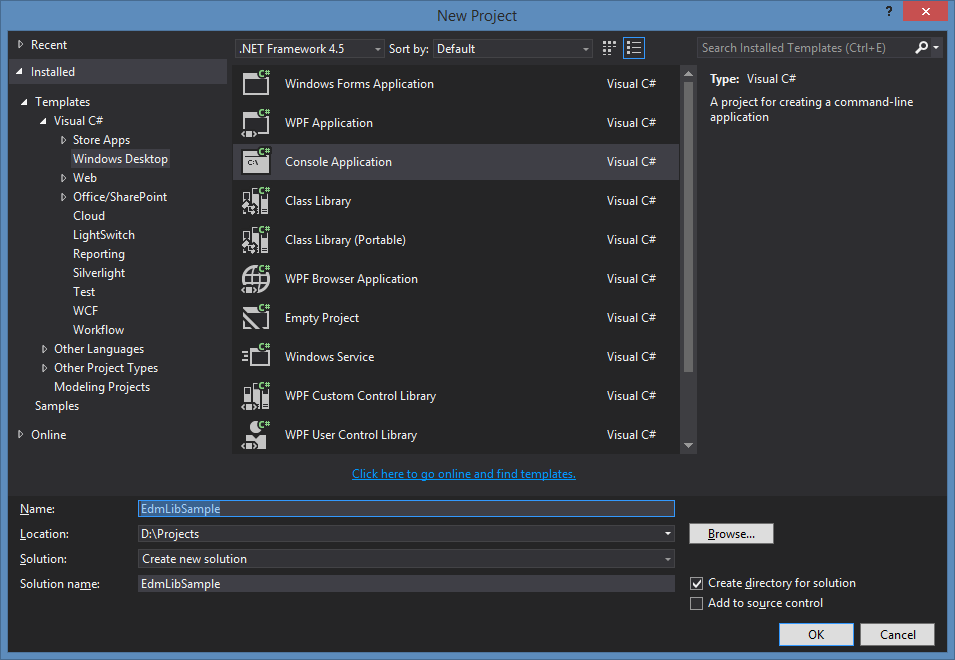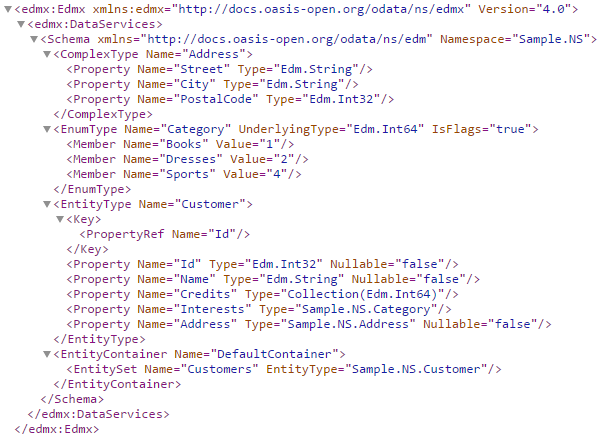Build a basic entity data model (EDM)
Applies To: # OData core lib v7 supported OData Core Lib V7
OData Core Lib V7
The EDM (Entity Data Model) library (abbr. EdmLib) primarily contains APIs to build an entity data model that conforms to CSDL (Common Schema Definition Language), and to read/write an entity data model from/to a CSDL document.
This section shows how to build a basic entity data model using EdmLib APIs.
Software used in this tutorial
Create a Visual Studio project
In Visual Studio, from the File menu, select New > Project.
Expand Installed > Templates > Visual C# > Windows Desktop, and select the Console Application template. Name the project EdmLibSample, and click OK.

Install the EdmLib package
From the Tools menu, select NuGet Package Manager > Package Manager Console. In the Package Manager Console window, type:
Install-Package Microsoft.OData.Edm
This command configures the solution to enable NuGet restore, and installs the latest EdmLib package.
Add the SampleModelBuilder class
The SampleModelBuilder class is used to build and return an entity data model instance at runtime.
In Solution Explorer, right-click the project EdmLibSample. From the context menu, select Add > Class. Name the class SampleModelBuilder.

In the SampleModelBuilder.cs file, add the following using directives to introduce the EDM definitions:
using Microsoft.OData.Edm;
Then replace the boilerplate code with the following:
namespace EdmLibSample
{
public class SampleModelBuilder
{
private readonly EdmModel _model = new EdmModel();
public IEdmModel GetModel()
{
return _model;
}
}
}
Add complex Type Address
In the SampleModelBuilder.cs file, add the following code into the SampleModelBuilder class:
namespace EdmLibSample
{
public class SampleModelBuilder
{
...
private EdmComplexType _addressType;
...
public SampleModelBuilder BuildAddressType()
{
_addressType = new EdmComplexType("Sample.NS", "Address");
_addressType.AddStructuralProperty("Street", EdmPrimitiveTypeKind.String);
_addressType.AddStructuralProperty("City", EdmPrimitiveTypeKind.String);
_addressType.AddStructuralProperty("PostalCode", EdmPrimitiveTypeKind.Int32);
_model.AddElement(_addressType);
return this;
}
...
}
}
This code:
- Defines a keyless complex type
Addresswithin the namespaceSample.NS; - Adds three structural properties
Street,City, andPostalCode; - Adds the
Sample.NS.Addresstype to the model.
Add an enumeration Type Category
In the SampleModelBuilder.cs file, add the following code into the SampleModelBuilder class:
namespace EdmLibSample
{
public class SampleModelBuilder
{
...
private EdmEnumType _categoryType;
...
public SampleModelBuilder BuildCategoryType()
{
_categoryType = new EdmEnumType("Sample.NS", "Category", EdmPrimitiveTypeKind.Int64, isFlags: true);
_categoryType.AddMember("Books", new EdmEnumMemberValue(1L));
_categoryType.AddMember("Dresses", new EdmEnumMemberValue(2L));
_categoryType.AddMember("Sports", new EdmEnumMemberValue(4L));
_model.AddElement(_categoryType);
return this;
}
...
}
}
This code:
- Defines an enumeration type
Categorybased onEdm.Int64within the namespaceSample.NS; - Sets the attribute
IsFlagstotrue, so that multiple enumeration members (enumerators) can be selected simultaneously; - Adds three enumerators
Books,Dresses, andSports; - Adds the
Sample.NS.Categorytype to the model.
Add an entity type Customer
In the SampleModelBuilder.cs file, add the following code into the SampleModelBuilder class:
namespace EdmLibSample
{
public class SampleModelBuilder
{
...
private EdmEntityType _customerType;
...
public SampleModelBuilder BuildCustomerType()
{
_customerType = new EdmEntityType("Sample.NS", "Customer");
_customerType.AddKeys(_customerType.AddStructuralProperty("Id", EdmPrimitiveTypeKind.Int32, isNullable: false));
_customerType.AddStructuralProperty("Name", EdmPrimitiveTypeKind.String, isNullable: false);
_customerType.AddStructuralProperty("Credits",
new EdmCollectionTypeReference(new EdmCollectionType(EdmCoreModel.Instance.GetInt64(isNullable: true))));
_customerType.AddStructuralProperty("Interests", new EdmEnumTypeReference(_categoryType, isNullable: true));
_customerType.AddStructuralProperty("Address", new EdmComplexTypeReference(_addressType, isNullable: false));
_model.AddElement(_customerType);
return this;
}
...
}
}
This code:
- Defines an entity type
Customerwithin the namespaceSample.NS; - Adds a non-nullable property
Idas the key of the entity type; - Adds a non-nullable property
Name; - Adds a property
Creditsof the typeCollection(Edm.Int64); - Adds a nullable property
Interestsof the typeSample.NS.Category; - Adds a non-nullable property
Addressof the typeSample.NS.Address; - Adds the
Sample.NS.Customertype to the model.
Add the default entity container
In the SampleModelBuilder.cs file, add the following code into the SampleModelBuilder class:
namespace EdmLibSample
{
public class SampleModelBuilder
{
...
private EdmEntityContainer _defaultContainer;
...
public SampleModelBuilder BuildDefaultContainer()
{
_defaultContainer = new EdmEntityContainer("Sample.NS", "DefaultContainer");
_model.AddElement(_defaultContainer);
return this;
}
...
}
}
This code:
- Defines an entity container
DefaultContainerwithin the namespaceSample.NS; - Adds the container to the model.
Note that each model MUST define exactly one entity container (aka. the default entity container) which can be referenced later via the _model.EntityContainer property.
Add an entity set Customers
In the SampleModelBuilder.cs file, add the following code into the SampleModelBuilder class:
namespace EdmLibSample
{
public class SampleModelBuilder
{
...
private EdmEntitySet _customerSet;
...
public SampleModelBuilder BuildCustomerSet()
{
_customerSet = _defaultContainer.AddEntitySet("Customers", _customerType);
return this;
}
...
}
}
This code directly adds a new entity set Customers to the default container.
Using factory APIs for EdmModel
In the above sections, to construct entity/complex types and entity containers, one has to first explicitly instantiate the corresponding CLR types, and then invoke EdmModel.AddElement() to add them to the model. In this version, a new set of factory APIs are introduced that combine the two steps into one, leading to more succinct and cleaner user code. These APIs are defined as extension methods to EdmModel as follows:
namespace Microsoft.OData.Edm
{
public static class ExtensionMethods
{
public static EdmComplexType AddComplexType(this EdmModel model, string namespaceName, string name);
public static EdmComplexType AddComplexType(this EdmModel model, string namespaceName, string name, IEdmComplexType baseType);
public static EdmComplexType AddComplexType(this EdmModel model, string namespaceName, string name, IEdmComplexType baseType, bool isAbstract);
public static EdmComplexType AddComplexType(this EdmModel model, string namespaceName, string name, IEdmComplexType baseType, bool isAbstract, bool isOpen);
public static EdmEntityType AddEntityType(this EdmModel model, string namespaceName, string name);
public static EdmEntityType AddEntityType(this EdmModel model, string namespaceName, string name, IEdmEntityType baseType);
public static EdmEntityType AddEntityType(this EdmModel model, string namespaceName, string name, IEdmEntityType baseType, bool isAbstract, bool isOpen);
public static EdmEntityType AddEntityType(this EdmModel model, string namespaceName, string name, IEdmEntityType baseType, bool isAbstract, bool isOpen, bool hasStream);
public static EdmEntityContainer AddEntityContainer(this EdmModel model, string namespaceName, string name);
}
}
So, for example, instead of
var entityType = new EdmEntityType("NS", "Entity");
// Do something with entityType.
model.AddElement(entityType);
you could simply
var entityType = model.AddEntityType("NS", "Entity");
// Do something with entityType.
Besides being more convenient, these factory APIs are potentially more efficient as advanced techniques may have been employed in their implementations for optimized object creation and handling.
Write the model to a CSDL document
Congratulations! You now have a working entity data model! In order to show the model in an intuitive way, we now write it to a CSDL document.
In the Program.cs file, add the following using directives:
using System.Collections.Generic;
using System.IO;
using System.Xml;
using Microsoft.OData.Edm;
using Microsoft.OData.Edm.Csdl;
using Microsoft.OData.Edm.Validation;
Then replace the boilerplate Program class with the following:
namespace EdmLibSample
{
class Program
{
public static void Main(string[] args)
{
var builder = new SampleModelBuilder();
var model = builder
.BuildAddressType()
.BuildCategoryType()
.BuildCustomerType()
.BuildDefaultContainer()
.BuildCustomerSet()
.GetModel();
WriteModelToCsdl(model, "csdl.xml");
}
private static void WriteModelToCsdl(IEdmModel model, string fileName)
{
using (var writer = XmlWriter.Create(fileName))
{
IEnumerable<EdmError> errors;
CsdlWriter.TryWriteCsdl(model, writer, CsdlTarget.OData, out errors);
}
}
}
}
For now, there is no need to understand how the model is written to CSDL. The details will be explained in the following section.
Run the sample
From the DEBUG menu, click Start Debugging to build and run the sample. The console window should appear and then disappear in a flash.

Open the csdl.xml file under the output directory with Internet Explorer (or any other XML viewer you prefer). The content should look similar to the following:

As you can see, the document contains all the elements we have built so far.
References
Feedback
Coming soon: Throughout 2024 we will be phasing out GitHub Issues as the feedback mechanism for content and replacing it with a new feedback system. For more information see: https://aka.ms/ContentUserFeedback.
Submit and view feedback for